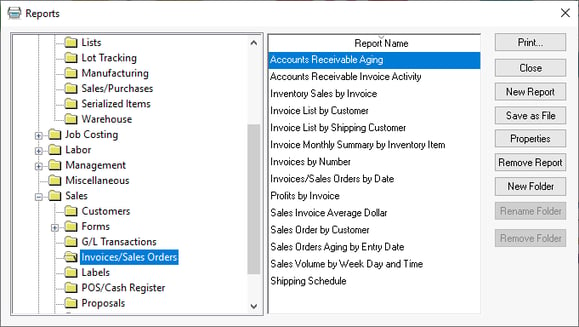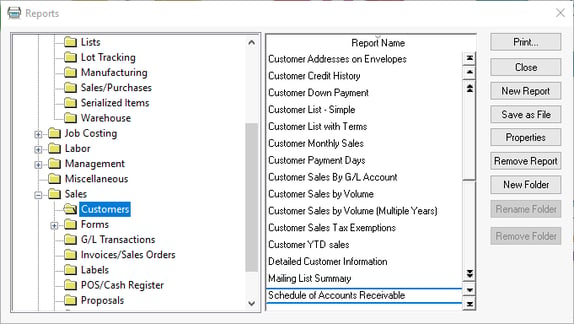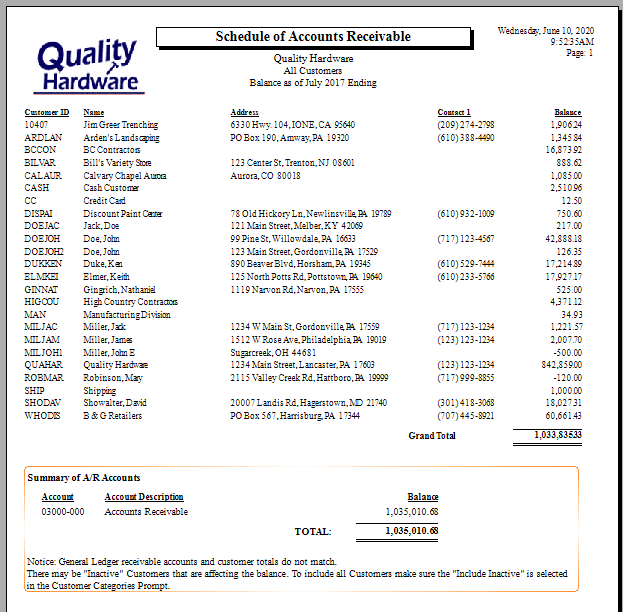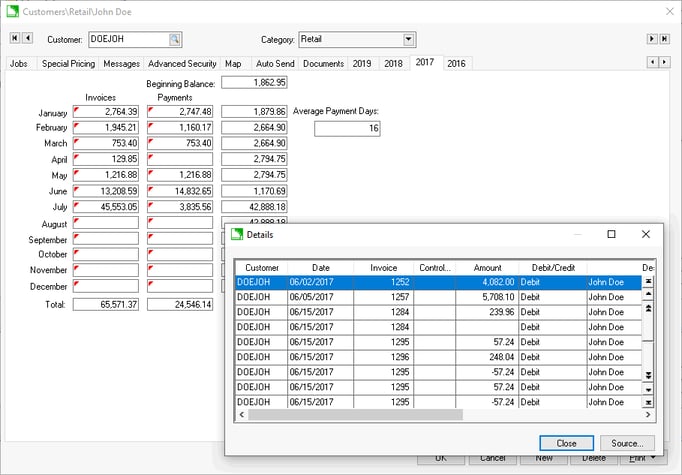Accounts Receivable Transactions
Accounts Receivable are unpaid invoiced transactions held by a business for goods supplied and/or services rendered that customers have not yet paid. Unpaid invoices generally include terms for payment within an agreed time frame.
Accounts Receivable (A/R) is shown in an accounting balance sheet as an asset. It is one of a series of accounting transactions dealing with the billing of a customer for goods and services that the customer has ordered. These may be distinguished from notes receivable, which are debts created through formal legal instruments called promissory notes.
Accounts Receivable Balance
Accounts Receivable General Ledger accounts within EBMS record the balance due by customers. The balance of the collective accounts receivable accounts must equal the history balance recorded for all customers.
- Sales invoice aging reports: Review Invoice Aging for steps to generate aging reports.
- Customer annual history tabs: Review Customer History to review the invoices and payments for individual customers.
- Reconcile balance with financial totals: Review Verifying General Ledger Balances for steps to run a utility to reconcile Accounts Receivable.
The EBMS software facilitates the ability to create multiple Accounts Receivable financial accounts.
Reconcile Accounts Receivable Balances
The most effective way to evaluate A/R balances is to combine the totals all Account Receivable accounts.
Complete the following steps to reconcile Accounts Receivable balances:
-
Launch Financials > Utilities > Verify Balances from the main EBMS menu. Review Verifying General Ledger Balances Utility for more details. Verify that the Month and Fiscal Year setting on the utility matches the period you wish to reconcile. All comparison reports must match the fiscal period.
-
The Accounts Receivable balance in the left column of the Verify Balances utility reflects the total of all A/R accounts. If the A/R balance needs to be adjusted, try one of the following:
-
Verify that all accounts receivable accounts in the general ledger are classified as accounts receivable. Review [Financials] Chart of Accounts > Account Classification for details on setting or changing an account classification.
-
Use a journal entry to adjust the Accounts Receivable financial account balance. Review the Creating Journal Entries documentation.
-
-
If the Customers balance in the right column is incorrect, then go to File > Reports > Sales > Customers > Schedule of Accounts Receivable report from the main EBMS menu. See copy of report below. Adjust any sales invoices or payments to balance the accounts receivable accounts with the balance of all sales invoices.
-
An A/R aging report is located at File > Reports > Sales> Invoices/Sales Orders > Accounts Receivable Aging from the main EBMS menu.
Accounts Receivable Reporting
Accounts Receivable Aging Report
The Accounts Receivable Aging report compiles a complete list of outstanding invoices for each customer along with aging details. An aging summary at the end of the report can be formatted multiple ways by setting report prompts. A customer summary is also available by selecting the Show prompt on the report.
This report can be accessed by going to File > Reports from the main EBMS menu and then selecting Reports > Sales > Invoices/Sales Orders > Accounts Receivable Aging report as shown below:

The report can be generated with an accurate aging and invoice balance list based on a past date. A Show Overdue Invoices Only option can be enabled to only show invoices that are overdue. (Double-click on any report to open up report setup options.)
The Show drop-down menu on the Report Options page gives the user a number of different formats. Options include Invoice Aging, Summary by Customer, and Invoice with Additional Information.
Review Invoice Aging for report examples with the Show prompt set to Invoice Aging.
Schedule of Accounts Receivable Report
The Schedule of Accounts Receivable report contains a summary A/R balance for each customer. This report can be accessed by going to File > Reports > Sales > Customers > Schedule of Accounts Receivable report as shown below:

The Schedule of Accounts Receivable report can be dated based on past monthly periods. This report can be used to list A/R details based on the end of past years, quarters, or months.

The summary of all A/R accounts will be listed, and a note will indicate if the customer balance does not match the General Ledger account balance.
Customer History
The monthly balance for each customer is found on each customer's history tab. 
Drill down on monthly invoice or payment by double-clicking on any total to view the detailed transactions. Click on an individual record to view the sales document. Review Customer History for more information on this subsidiarity ledger.
Increasing and Decreasing A/R Balance
The Accounts Receivable balance is affected by the following transactions, including invoices and credits for the customer. Note that sales orders do not affect the A/R balance until the order is processed into an invoice.
- Processing a sales invoice: Review Processing a Sales Invoice or Batch Processing Invoices for details on the processing step.
- Voiding a sales invoice: Review Voiding a Sales Invoice for steps to reverse A/R transactions.
- Processing a credit: Review Processing Customer Credits for instructions to create and process credits.
- Processing a journal entry to adjust a balance: Review Sales Journal Entry to make manual A/R balance adjustments.
The Accounts Receivable balance is decreased as payments are applied to sales invoices.
- Customer Payments: Review Processing Customer Payments for instructions to process various payment options including cash, ACH, payment card, and other automated payments.
- Voiding Customer Payments: Review Voiding Customer Payments for instructions to reverse a payment.
- Returned payment: Review Process Returned Check for instructions to reverse the deposit and AR balance when processing a bad check.
Note that finance charges applied to an invoice are not credited to the Accounts Receivable balance but are processed when the finance charges are paid. Review Customer Finance Charges for more details on this process.